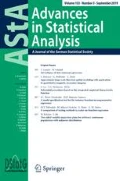1 Correction to: AStA Advances in Statistical Analysis https://doi.org/10.1007/s10182-018-00331-3
In the original paper (Morais et al. 2018), we incorrectly stated that
where \(\chi ^2_p (\lambda )\) represents the noncentral Chi-square distribution with p degrees of freedom and noncentrality parameter \(\lambda = (\varvec{\varSigma }_0^{1/2} \, \varvec{\delta })^\top \, \varvec{\varSigma }^{-1} \,(\varvec{\varSigma }_0^{1/2} \, \varvec{\delta })\). This statement is only valid when \(\varvec{\varSigma }= \varvec{\varSigma }_0\), according to Anderson (1958, p. 55), Muirhead (1982, p. 26, Theorem 1.4.1) and Mathai and Provost (1992, p. 201, Corollary 5.1.3a). In this particular case, we have \(\lambda = \varvec{\delta }^\top \times \varvec{\delta }\).
When \(\varvec{\varSigma }\ne \varvec{\varSigma }_0\), we can capitalize on various series representations for the c.d.f. of \(T^{(1)}\), such as the one mentioned by Mathai and Provost (1992, p. 95, Theorem 4.12b.1), truncate such series, and provide approximations to the c.d.f. of \(T^{(1)}\). Instead, we favoured the representation of the quadratic form \(T^{(1)}\) as in Mathai and Provost (1992, p. 29, formula (3.1a.4)) or Duchesne and Micheaux (2010). By doing so, this control statistic can be written as a weighted sum of independent noncentral Chi-square random variables (Mathai and Provost 1992, p. 29),
where \(\lambda _i, \, i=1,\ldots ,p\), are the eigenvalues of the matrix
\(\tau _i\) is the square of the ith element of vector
\(\varvec{U}\) is the orthogonal matrix such that
Unfortunately, the incorrection we mentioned was only detected after the publication of Morais et al. (2018). The authors apologize for it and remind the reader that the correct marginal distribution of \(T^{(1)}\), when \(\varvec{\varSigma }\ne \varvec{\varSigma }_0\), ought to be considered in the statement of Theorem 1 in the original publication.
Fortunately, this had no bearing on the control limits of the joint scheme of type 1. However, the out-of-control ARL values referring to this joint scheme and to \(\varvec{\varSigma }\ne \varvec{\varSigma }_0\), in tables 2–7 of Morais et al. (2018), had to be recalculated. They were obtained by taking advantage of the package CompQuadForm (Micheaux 2017) for the R statistical software (R Core Team 2013); the distribution function of the quadratic form in normal variables \(T^{(1)}\) was computed using Imhof’s method (1961), with absolute and relative accuracies equal to \(10^{-6}\).
The reader must keep in mind that the out-of-control ARL values in Tables 2, 3, 4, 5, 6 and 7 refer to the joint schemes of type 1 with the parameters in Table 1 taken from Morais et al. (2018, Table 1).
Moreover, the out-of-control ARL values are listed in Tables 2, 3, 4, 5, 6 and 7 in order corresponding to the value in the original paper, the corrected value (in italic), and the corresponding estimate (obtained by Monte Carlo simulation with \(10^6\) replications), for each value of \(\delta \).
The correct out-of-control ARL values when \(\varvec{\varSigma }\ne \varvec{\varSigma }_0\) in Tables 2, 3, 4, 5, 6 and 7 are rarely larger than the ones in the original paper. In this particular case, the values are set in bold, but they are still smaller than the ones of the two competing joint schemes described in Morais et al. (2018). Furthermore, the ARL reductions are in some cases substantial.
Consequently, the correct ARL values we obtained serve to increase rather than to lessen our belief that the joint scheme 1 has the best overall ARL performance, as we mentioned in the abstract and the conclusions and recommendations of Morais et al. (2018). Unsurprisingly, the ARL profiles of figures 1–4 of the original paper were not redrawn.
References
Anderson, T.W.: An Introduction to Multivariate Statistical Analysis. Wiley, New York (1958)
Duchesne, P., Micheaux, P.: Computing the distribution of quadratic forms: further comparisons between the Liu–Tang–Zhang approximation and exact methods. Comput. Stat. Data Anal. 54, 858–862 (2010)
Imhof, J.P.: Computing the distribution of quadratic forms in normal variables. Biometrika 48, 419–426 (1961)
Mathai, A.M., Provost, S.B.: Quadratic Forms in Random Variables. Dekker, New York (1992)
Micheaux, P.: Package ‘ompQuadForm’ (2017). https://cran.r-project.org/web/packages/CompQuadForm/index.html. R package version 1.4.3
Morais, M.C., Schmid, W., Ramos, P.F., Lazariv, T., Pacheco, A.: Comparison of joint control schemes for multivariate normal i.i.d. output. AStA Adv. Stat. Anal. 12, 1–31 (2018). https://doi.org/10.1007/s10182-018-00331-3
Muirhead, R.J.: Aspects of Multivariate Statistical Theory. Wiley, Hoboken (1982)
R Core Team: R: a Language and Environment for Statistical Computing. R Foundation for Statistical Computing, Vienna, Austria (2013). http://www.R-project.org/
Author information
Authors and Affiliations
Corresponding author
Additional information
Publisher's Note
Springer Nature remains neutral with regard to jurisdictional claims in published maps and institutional affiliations.
The original article can be found online at https://doi.org/10.1007/s10182-018-00331-3.
Rights and permissions
About this article
Cite this article
Morais, M.C., Schmid, W., Ramos, P.F. et al. Correction to: Comparison of joint control schemes for multivariate normal i.i.d. output. AStA Adv Stat Anal 103, 289–303 (2019). https://doi.org/10.1007/s10182-018-00344-y
Published:
Issue Date:
DOI: https://doi.org/10.1007/s10182-018-00344-y

